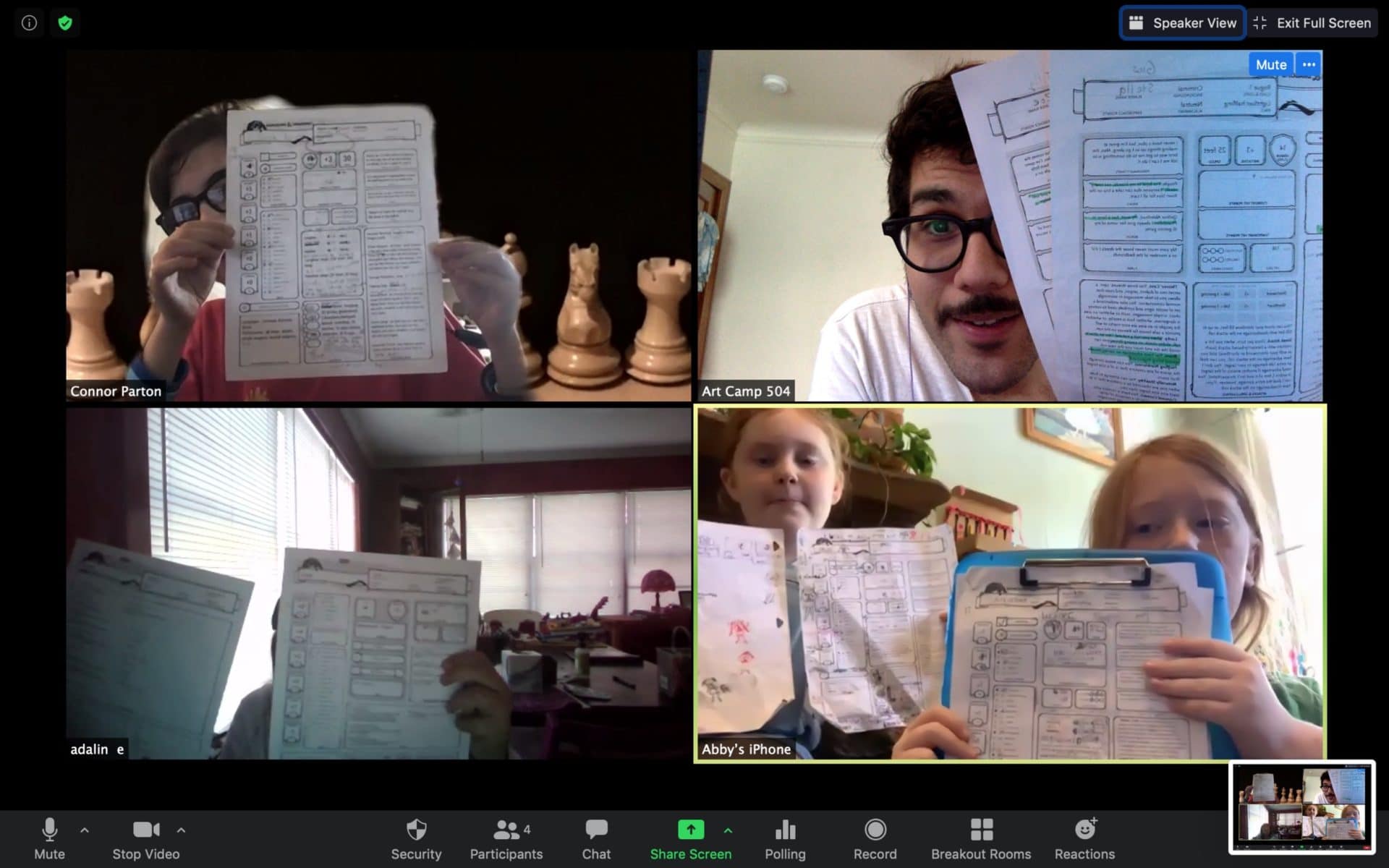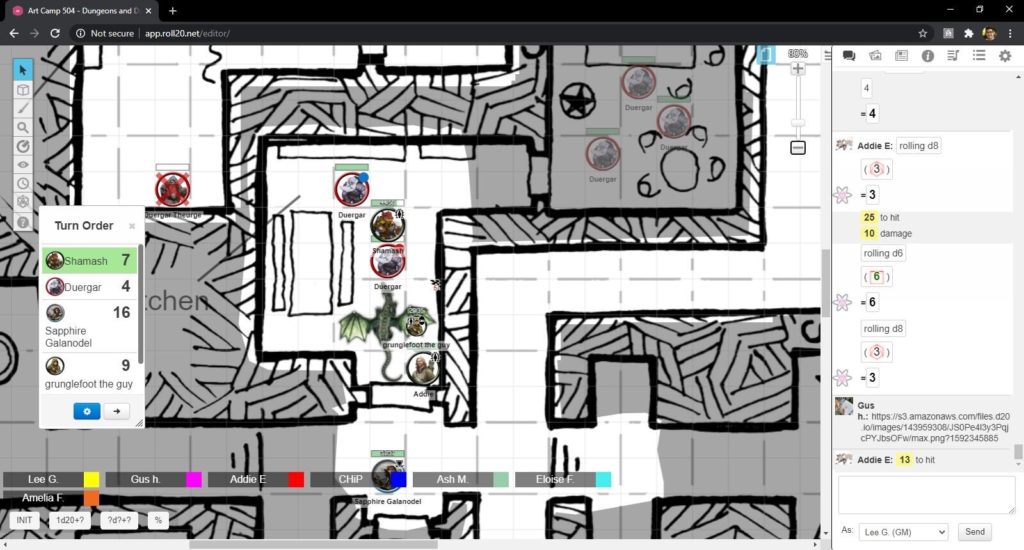How To Run D&D For Kids
Published on March 25, 2021, Last modified on July 14th, 2021
This article was sponsored by Art Camp 504! Art Camp 504 is a virtual program providing children an opportunity to learn, create, and socialize in a fun and friendly space.
The team at Art Camp 504 are masters at all things creative and offer virtual D&D programs for children aged 7 – 14. To learn more about their D&D for kids classes and other workshops, visit their programs page.

Table of Contents
Running Dungeons and Dragons for Kids
With the growing popularity of Dungeons and Dragons, many parents are starting to consider it as a worthwhile pastime for their children. At Arcane Eye, we don’t have any of our children of our own (yet!), but we have many questions: What exactly are the benefits of Dungeons and Dragons for kids? How would I go about introducing my kids to the game?
Well, what better person to talk to than Sam Bass, director of the New Orleans-based non-profit Art Camp 504, and Lee Garcia, one of Art Camp 504’s DMs. Established in 2016, Art Camp 504 has strived to improve access to high-quality art education for children and adults alike.
Art Camp 504’s online Dungeons and Dragons class introduces kids to the wonderful world of D&D, teaching them the mechanics of the game, how to roleplay, and how to work as a team, all through cooperative storytelling. Students meet virtually using Roll20 and Zoom, going on adventures together and improving their skills.
We learned a ton from Sam and are really excited to share it all with you!
Benefits of D&D For Kids
Not only is Dungeons and Dragons loads of fun, Lee tells us that learning to play at a young age can be very beneficial to a developing child. Beyond the obvious, such as math, problem-solving, and strategizing, he explains that some of the greatest advantages he has seen in his students lie beneath the surface.
According to Lee, “there’s communication skills and mutual understanding — kids must work together as a party and discuss their actions with each other to agree on the best solution to a problem; but I think the biggest boon of playing D&D at a young age is that it asks the player to imagine themself as a hero, as a version of themself that they may want to aspire to be more like, and D&D mechanically asks the player to continually improve their character (leveling up, in the game) and grow after facing challenges.”
The biggest boon of playing D&D at a young age is that it asks the player to imagine themself as a hero
— Lee Garcia
Indeed, Lee has opened our eyes to something that should have been evident from the start. The intrinsic benefits that many of us experience when playing D&D — imagining ourselves as a winner, a person who works with others to take on monumental tasks and succeed at them — extends to people in all walks of life.
Because of the complexity that surrounds D&D, many of us only discover its magic and the lifelong benefits it provides when we are older. To be able to share this joy with the younger generation is a gift in itself. Lee said it best, “[Dungeons and Dragons] might be my favorite game. But I think there’s an even deeper value other than pure entertainment. D&D can help you see yourself and your friends in a safe, creative space. You can play however you like, be what you want to be. Everyone’s just there to have fun!”
How to Introduce Kids to D&D
Introducing kids to Dungeons and Dragons, Sam maintains, has never been easier! No longer is D&D considered to be something for the fringe of society, taking place in stuffy basements. In fact, bringing up D&D is usually met with resounding enthusiasm.
“I think the things that are popular with kids today — TV, movies, video games — are already very strongly connected to the fantasy elements of D&D.” She continues, “So the idea of joining a game of D&D already sounds fun before you even sit down at the table.”
When it comes time to play, Lee likes to open with a story. Telling a story serves two purposes; not only does the story immerse students in the experience, but it also serves as a way to introduce the setting and themes for the adventures to come.
Teaching kids the rules of Dungeons and Dragons is also not nearly as daunting as it seems. After telling the opening story, Lee finds it best to let students peruse their character sheets and check out all the different dice, introducing new concepts as they come up organically. Kids are smart! Sometimes we forget how quickly an engaged child can pick up a new skill or learn something. Lee explains, “I’m always surprised how the rules of combat in D&D are almost second-nature to most kids — it’s like a video game/board game instinct.”
Once you’re in the swing of things, let the players’ imaginations run wild! Kids are highly creative, and D&D is the perfect outlet for their imaginations. Lee stresses that the Dungeon Master should be very adaptable, and change their approach and story direction based on the characters the kids create. “If the kids find a certain NPC hilarious, or if the kids set specific goals for their characters, I like to try and focus in on those elements and draw them into the story.”
At the end of the day, the goal is for everybody to feel included and to be having fun. If the kids are immersed and enjoying themselves, you’re doing it right!
Playing D&D With Kids Online
Art Camp 504’s D&D lessons are completely virtual. We were curious how this might affect game sessions when playing with a younger group.
Sam finds playing online with kids to be very feasible and even has some advantages over playing in-person. Using software like Roll20 streamlines a lot of the more fiddly bits of the game, such as rolling dice and determining ability score modifiers. The virtual interface of Roll20 causes the whole experience to feel more like a video game than the traditional pen-and-paper method, making it more stimulating for many kids.

That’s not to say playing Dungeons and Dragons online doesn’t come without its own issues. Sam says, “The biggest challenge of playing online would probably be hard to describe — the interpersonal connection between the kids in the party, non-verbal communication, things like that. And when you do anything online there’s always the possibility of tech-related problems.”
Despite these hindrances, playing online is well worth the effort, especially in today’s climate. “Being able to meet online and play a game makes it a lot easier for groups to convene together, even hundreds of miles apart. And it’s safer [for social distancing], of course.”
D&D Adventures For Kids
Lee has found success with published beginner adventures, such as Lost Mine of Phandelver, when teaching kids to play Dungeons and Dragons. The most important thing, as stated earlier, is to adapt these adventures to the kids’ interests and the characters they have created. In addition, make sure the module you choose is relatively short, easy to understand, and family-friendly.
We put together some adventures from other sources that could be a great jumping off point when teaching kids how to play D&D.
- D&D Adventures for Kids – Free adventures designed specifically with kids in mind. Good range of themes ranging from saving a pet dog to investigating a mysterious death.
- The Heroes of Hesiod – A simplified and action-packed adventure designed to teach kids the fundamentals of D&D combat.
- Truly Madly Deeply: Level Zero to Hero – This four-part adventure provides a great introduction and satisfying story arch to young players that are new to D&D.
- DMs Guild – The largest resource for unofficial Dungeons and Dragons content. Results can be filtered for “family oriented” and “adventures” to find beautifully crafted adventures for younger players, such as Clonker’s Guide to Being a Hero.
Closing Words
We’ve learned that teaching kids to play Dungeons and Dragons is not nearly as difficult as it seems, and is rewarding in so many ways. Whether you have kids of your own or want to be the coolest aunt/uncle in the world, give it a go. You may just find yourself having the time of your life.
Thank you so much to Sam and Lee for sharing your knowledge. Art Camp 504 is an amazing organization, so we highly recommend checking them out!
This article was sponsored by Art Camp 504!
Art Camp 504 is a virtual program providing children an opportunity to learn, create, and socialize in a fun and friendly space.
The team at Art Camp 504 are masters at all things creative and offer virtual D&D programs for children aged 7 – 14. To learn more about their D&D for kids classes and other workshops, visit their programs page.


This would’ve been my dream as a kid! So exciting to see good recommendations of kid friendly content as well! Keep up the great work!
Thank you for the kind words Daniel 🙂